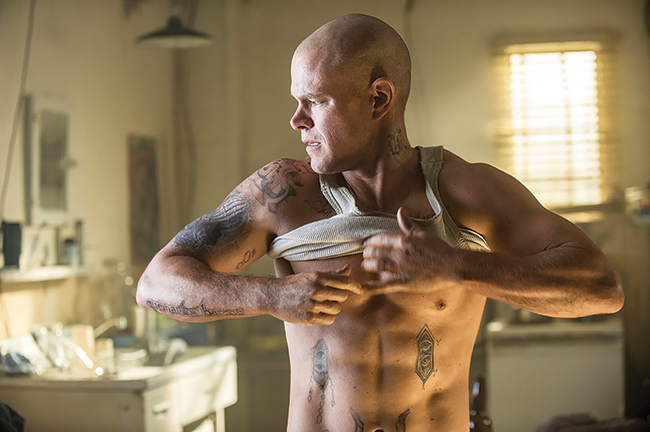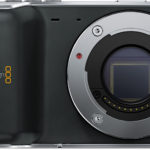
Trouble In Paradise – The Grading Of ‘Elysium’
Posted on Oct 10, 2013 by Alex Fice
Elysium featured the first mention of something called the ‘Shadow’ conform.
Elysium projects us in to a future where Earth’s rich and influential have de-bunked to a space station orbiting the planet while the rest of us fight it out in a degenerating society. We talked with colourist Andrea Chlebak about the role of the Digital Intermediate in the movie.
The summer has been full of large scale effects-heavy movies and Elysium is no different. Perhaps the interest is that this is Neil (District 9) Bloomkamp’s follow up and this time he has a bigger budget.
Andrea Chlebak worked on the movie at her facility in Vancouver called Film Central. She was the colourist for the movie but as she explains the workflow took on a whole new meaning in post collaboration and they in fact coined a new phrase to explain how they did it.
“The scale of the project is quite large so we took an in-depth approach and were able to offer a massive amount of flexibility on all the creative processes for editorial, visual effects and then for DI as well. Schedules usually are pushed to the very last day so we wanted to make sure everybody was going to have a good amount of time within the process and nothing was going to get too condensed.
“We got involved during principal shooting and started developing a look really early on primarily for visual effects because when you’re putting in man-sized droids in to a scene you want to make sure that every texture and element is going to come across looking as you expect from VFX right through to DI, you don’t want there to be any surprises along the way. That was the big concern at the beginning.
“So basically we decided to do a ‘look session’ with as much footage as we had from the film which had just begun shooting in Vancouver. Our big thing was colour management so we implemented ACES (Academy Color Encoding Specification) in our workflow and that made sure we could match across all facilities – we had a big editorial office across the street, we had Image Engine, a VFX company a couple of streets down and then ourselves, so we were all lined up in terms of making sure we were all looking at the same imaging.
“We also got involved with pulling the plates for visual effects. So instead of them pulling the plates from the footage they would send us lists and we would pull them and do pre-grade on them with that look involved, the show look that I developed with Neil Bloomkamp, the director.
Shadow Conform
“From there we moved in to something called ‘Shadow Conform’ which is a term that we might trademark. Basically it’s like a rolling DI or a version of a file-based online workflow. As soon as there’s a fine cut or even a rough cut, it doesn’t really matter, any version of the cut, they were cutting in reels, editorial would send us EDLs and we would basically stitch the show together in this full resolution format and because we had visual effects plates we were able to bring those in. So we had a version of the film with essentially no holes running throughout the entire process of editorial and visual effects.
“Usually from our experience we would be doing DI essentially getting condensed in to the last few weeks so you wait for 90 percent or even 100 percent of the visual effects are completed and then you would just conform the whole show. Visual effects is a really long workflow period, they could extend their delivery schedule because as we’re DI we’re able to start much earlier and editorial as well were able to extend their editing process because it wasn’t like a huge pocket of work that had to be done the minute they said ‘OK we’re locked’. But as the DI overlapped both of those processes it gave everyone more time including ourselves to actually start working on the film.
“It makes perfect sense and we wondered why we don’t do it more. Of course the reasons are financial and keeping material of that resolution online for lets say six months is actually kind of a big deal. But it made for such a smooth, seamless process because essential we were doing DI right almost up until the last minute and actually dropping in the final three or four final effect shots that day. So they were able to make it look as good as possible without having to say ‘this is good enough’ and kicking out some shots.
“The only other thing to add to that workflow idea was we worked in Open EXR as well for the whole thing. That is a process that we’re trying to adopt and a lot of other post production houses are getting in to that. It’s essentially the ILM workflow where it’s open sourced, everybody has access to full range files and Metadata tracks through everything. Visual effects wanted to work in EXR and we managed the DI that way as well.
RED Footage
“With the RED it can seem like every different project has different requirements depending on the DP and how they’re going to shoot. For this project there was an extensive round of testing just to make sure that when we did commit to one decode setting it was going to offer the best results for the particular material that we had in hand. It’s almost like you can’t decide on one until you see what they’ve got, what kind of colours show up, that kind of thing.
 Colourist Andrea Chelbak handled the DI for the movie.
Colourist Andrea Chelbak handled the DI for the movie.
“We have been doing a lot of RED work so we’re pretty accustomed to what was working, so we were half way there and then when we got the specific material from the show and looked at it and decided ‘this colour processing works a little bit better’, lets do specific things with saturation or exposure, that kind of thing. There are always going to be scenes that are shot quite differently, under or over exposed, you just have to go back and review the settings for those.
“But it has a pretty good consistency once you have figured out that sweet spot of how to decode the files.”
Look Of Honesty
”Neil and Trent Opaloch, his DP on Elysium and District 9, have a style forming from their work on previous movies and shorts. I don’t know if it’s deliberate but it’s definitely apparent. I got invited in to the initial process of setting a style and was able to identify what they were going for. In finding a look I would think I was working wholly with Neil to ascertain exactly what he was going for. He’s very articulate so it didn’t take very long to figure out what he wanted. His big thing is honesty and realism, he tends to blend futurism and believability, it’s a kind of a visual paradox in some ways, you’ve got space ships and droids and explosions and then we have to make it look real.
“So I looked to make it look as natural as possible, we don’t want to pump up the skin tones, we don’t want super desaturated. In fact it’s almost as if we didn’t want the look to play a major role. You don’t want a filtration between the audience and story. So we wanted to put it in the subconscious and play with it very subtly. Ironically to be able to do that requires quite a bit of time. You have to go away and come back to it, then you analyse the scenes, that scene may look too intense now so we can perhaps remove some of the colour work and this scene doesn’t look intense enough so we have to boost up some of the contrast, that kind of thing. You have to go and come back and do a few rounds with it, something we wouldn’t have been able to do if we had condensed our schedule.
“We didn’t use our LUTs on set, we followed a more traditional pipeline with basic dailies with curves on-set. Neil could separate dailies from DI very easily, some people have ‘dailies love’ but that wasn’t the case with Neil as he would say ‘No I don’t even care what that looked like’ and would want to start from scratch at the DI. He recognised that those are two different processes.
“We’re actually trying to work on a system where you can have one place where the data is stored and where everyone can access that from it’s point so it’s not getting copied around to a number of different facilities all over the world. For the movie there was probably many, many iterations of files everywhere and it definitely adds up datawise.
“We were lucky enough to have a pretty good infrastructure in place but ideally moving forward you’d have something a little bit more central for everything and then you’d have pipes where people could access things and people could work off that location.
“We also worked in the resolution that was captured on which we’re calling 3.3k which was an anamorphic version from the Epic camera. They did shoot a series of 5k images but they really wanted that anamorphic look so the resolution of the images actually captured was 3296 by 1350.
“In terms of re-lighting or windowing that was fairly minimal simply because Neil was heavily involved in the grading process and we were looking at scenes every other day so principally it was not his style to think if drawing shapes and re-lighting however because of some of the extreme lighting conditions mainly in the Mexico scenes we did do secondaries across 60 percent of the show which was more selection of certain colours rather than windows. There were lots of layers but that was more to do with turning things off and on to review the effects of them.
“The show’s not heavily shaped, probably the most creative shaping that I was doing was in a big scene where Matt Damon is essentially fighting a droid. Which in reality was a guy in a grey suit! That was demanding in as much as keeping it ‘honest’. There were grads across the sky and some re-lighting mainly because there was a series of really quick cuts shot over five different times of day over two different days.”













